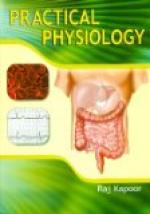155. Absorption from the Mouth and Stomach. The lining of the mouth and oesophagus is not well adapted for absorption. That this does occur is shown by the fact that certain poisonous chemicals, like cyanide of potash, if kept in the mouth for a few moments will cause death. While we are chewing and swallowing our food, no doubt a certain amount of water and common salt, together with sugar which has been changed from starch by the action of the saliva, gains entrance to the blood.
In the stomach, however, absorption takes place with great activity. The semi-liquid food is separated from the enormous supply of blood-vessels in the mucous membrane only by a thin porous partition. There is, therefore, nothing to prevent the exchange taking place between the blood and the food. Water, along with any substances in the food that have become dissolved, will pass through the partition and enter the blood-current. Thus it is that a certain amount of starch that has been changed into sugar, of salts in solution, of proteids converted into peptones, is taken up directly by the blood-vessels of the stomach.
156. Absorption by the Intestines. Absorption by the intestines is a most active and complicated process. The stomach is really an organ more for the digestion than the absorption of food, while the small intestines are especially constructed for absorption. In fact, the greatest part of absorption is accomplished by the small intestines. They have not only a very large area of absorbing surface, but also structures especially adapted to do this work.
157. The Lacteals. We have learned in Section 144 that the mucous lining of the small intestines is crowded with millions of little appendages called villi, meaning “tufts of hair.” These are only about 1/30 of an inch long, and a dime will cover more than five hundred of them. Each villus contains a loop of blood-vessels, and another vessel, the lacteal, so called from the Latin word lac, milk, because of the milky appearance of the fluid it contains. The villi are adapted especially for the absorption of fat. They dip like the tiniest fingers into the chyle, and the minute particles of fat pass through their cellular covering and gain entrance to the lacteals. The milky material sucked up by the lacteals is not in a proper condition to be poured at once into the blood current. It is, as it were, in too crude a state, and needs some special preparation.
The intestines are suspended to the posterior wall of the abdomen by a double fold of peritoneum called the mesentery. In this membrane are some 150 glands about the size of an almond, called mesenteric glands. Now the lacteals join these glands and pour in their fluid contents to undergo some important changes. It is not unlikely that the mesenteric glands may intercept, like a filter, material which, if allowed to enter the blood, would disturb the whole body. Thus, while the glands might suffer, the rest of the body might escape. This may account for the fact that these glands and the lymphatics may be easily irritated and inflamed, thus becoming enlarged and sensitive, as often occurs in the axilla.




